Economic Geography Grade 12 Questions and Answers
Economic Geography Grade 12 Questions and Answers:
Economic Geography Grade 12 Questions and Answers
Refer to FIGURE 3.1 showing models of urban structure. Choose the correct answer from the options given in brackets to make the statement TRUE. Write only your answer next the question numbers

- The model which shows land use arranged in wedges is known as the (multiple nuclei/sector) model. Answer:
- In the (multiple nuclei/concentric zone) model the CBD is the focal point around which the urban area develops.
- Industries and low-cost housing develop along main roads or railways in the (concentric zone/sector) model.
- The (sector/multiple nuclei) model is most applicable to modern cities.
- The (sector/concentric zone) model does not consider development along transport routes.
- Cities that have several focal points around which urban development occurs are examples of the (concentric zone/multiple nuclei) model.
- The (sector/multiple nuclei) model displays characteristics of the concentric zone model.
Answers:
- Sector
- Concentric zone
- Sector
- Multiple Nuclei
- Concentric zone
- Multiple Nuclei
- Sector
Refer to FIGURE 3.3, a graph on rural depopulation

Define the Concept of Rural Depopulation
Rural depopulation refers to the decline in the population numbers in rural areas as people move to urban regions for better opportunities and living conditions.
Determine the Number of People Living in Rural Areas of South Africa in 2004
In 2004, approximately 21-23 million people were living in rural areas in South Africa.
Is the Rural Population Showing an Increase or Decrease from 2004 to 2020?
The rural population in South Africa has shown a decrease from 2004 to 2020.
How Will This Trend Have a Negative Impact on the Standard of Living of the Rural Population?
The decrease in population numbers in rural areas can negatively impact the standard of living in several ways:
- Reduced municipal services: Fewer people paying for municipal services leads to less availability of these services.
- Economic decline: As people leave, businesses close due to a lack of customers, resulting in increased unemployment and poverty.
- Service reduction: Closing of essential services like schools and healthcare.
- Brain drain: Skilled individuals leaving, leading to less investment and innovation.
- Social issues: Increased crime and social ills among the remaining vulnerable population.
- Property values: Decrease in property values and local economic stagnation.
- Increased dependency: Higher dependency on social services and more child-headed families.
- Longer travel: Greater distances to access services in urban areas.
Explain TWO Social Factors That Contributed to Rural Depopulation in South Africa
- Unemployment: Due to businesses closing down and mechanisation reducing the need for manual labour.
- Lack of Services: Poor basic services and lack of recreational, cultural, and entertainment facilities due to less investment.
Suggest TWO Sustainable Strategies to Encourage People to Return to Rural Areas
- Accelerate Land Reform: Enable the poor and landless to obtain land for farming, creating more job opportunities.
- Decentralise Industries: Create job opportunities through the decentralisation of industries from urban areas to rural areas, improving local economies and services.
